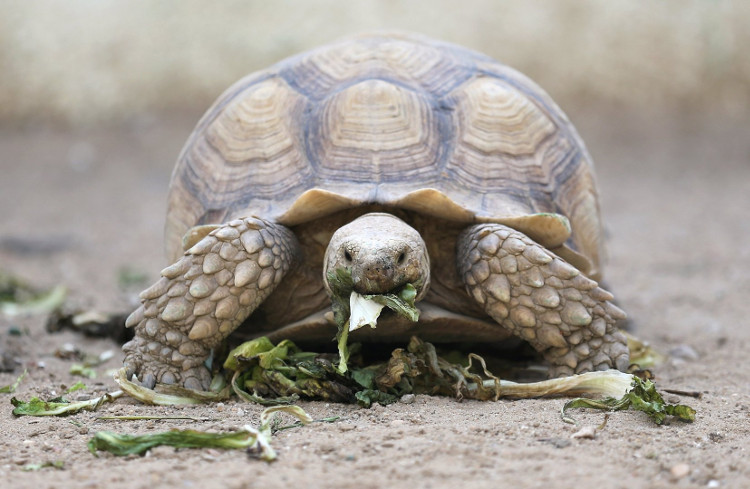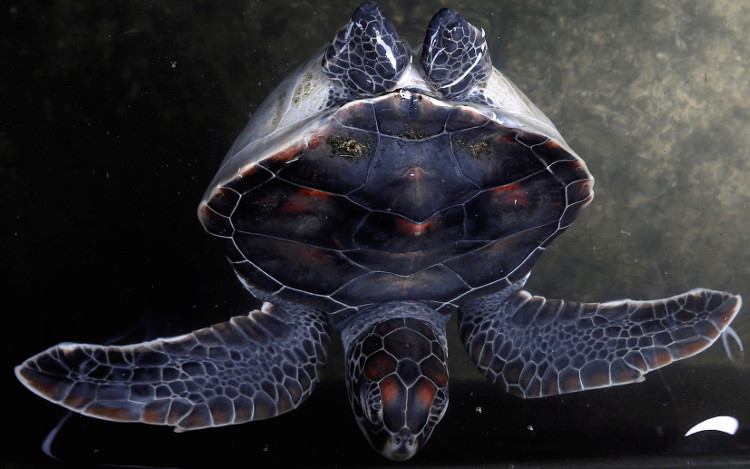Did you know: turtles survive through the winter by ... breathing on the butt
Cold winter comes, clean water turtles hibernate in the frozen lake, change the metabolism and oxygen uptake in the water through their . buttocks.
Turtles are species - so their body temperature changes according to the external environment. If the underwater temperature is 1 degree C, then the temperature of the turtle is the same.
But turtles have lungs and they breathe normal air. So when the winter is cold, the water is frozen, how can the turtle breathe when it can't reach the surface? The answer lies in the relationship between turtle body temperature and within them.

Turtle's body temperature changes according to the external environment.
Turtles in cold water environments will metabolize more slowly. The cooler the weather, the slower the metabolism of turtles, resulting in less energy and oxygen.
Therefore, when turtles hibernate, they will live on the energy stored in the body, and absorb oxygen in the water by moving parts containing many blood vessels under the skin. In this way, turtles can have enough oxygen for their minimum needs without having to use their lungs to breathe. And the area with the most blood vessels on the turtle's body is . their buttocks .

So, it's not wrong to say that turtles who breathe on their buttocks.
However, turtles' winter resistance is limited. Adult turtles are incapable of tolerating the freezing cold of the outside air, because such weather conditions will cause their bodies to appear ice crystals that cause them to die. It is for this reason that clean water turtles will often be in a water environment, where their body temperature is stable and never freezes.
In fact, only the water surface is exposed to the frozen atmosphere. The water in the lake will usually have a stable temperature throughout the winter, very suitable for some cold-blooded animals to live in the water to hibernate.
But at the same time, when hibernating here, turtles will face two problems: they cannot rise to the surface to get oxygen, and the little oxygen in the lake will have to share with some other animals. female a.
As the winter went by, the amount of oxygen in the lake dried up, causing the lake to fall short of oxygen, or depleting oxygen. Some turtles may survive in the absence of oxygen, but some others do not.

Some turtles may survive in the absence of oxygen, but some others do not.
Snapping turtles and flower turtles pass the winter in the lake by changing metabolism to not need to use oxygen. However, if this lasts too long, it will endanger the lives of these turtles, because in their muscle tissue, acid will arise, resulting from the process of changing metabolism.
But how long is it considered "too long" ? For Snapping turtles and flower turtles, they can survive on the lake in the cold winter for more than 100 days . In terms of resilience in the absence of oxygen, flower turtles are almost "unmatched" , because they deal with muscle acid production by using calcium in their shells to neutralize acid.
By spring, when the turtles finish hibernation, their bodies are almost just a muscle mass. Because the amount of lactic acid in these turtles' muscles is so much, making their mobility worse than before, making them a good prey for predators. Turtles will take a period of early spring to increase metabolism and eliminate lactic acid in the muscle, before they can return to normal.

In Ontario, where winters last for a long time, many turtles hibernate over half their life.
For biologists, the best time to work is spring and summer, when the animals are most active. However, in Ontario, where the winter lasts for a long time, many turtles hibernate over half their life.
Research to understand how these turtles work in the winter is paramount for biologists to carry out conservation and protection of habitats for turtles, when 2/3 The number of turtles currently in the Red Book is very high.
A team of researchers has attached a small device to the tortoise shell, so they can monitor their temperature as they hibernate. The results they obtained were that these turtles hibernated in groups, and every year they returned to the winter every year.
However, this is only a very small part of what the research team can observe about the survival of turtles in the cold winter.
- Pet miracle survived 10 months
- Respiratory turtle with buttocks
- Technology allows people to breathe underwater
- Tooth turtles can last more than 100 million years ago
- The most exotic turtles in the world
- Video: Youtuber makes a butt-wiping machine
- Humans have been cheated for hundreds of years by turtles without knowing
- Practice breathing for full body health
- Turtles have two heads and six legs
- Things to change when exercising in autumn and winter
- Spectacle of clogged turtles, queuing through strange bridges
- Hundreds of deadly Golfinas sea turtles are found in the Mexican coast
 Animal 'suffering' after hibernation
Animal 'suffering' after hibernation Why do goats climb well?
Why do goats climb well? Scientists were surprised to see chimpanzees eating turtles
Scientists were surprised to see chimpanzees eating turtles Giant catfish died deadly due to drought in Thailand
Giant catfish died deadly due to drought in Thailand